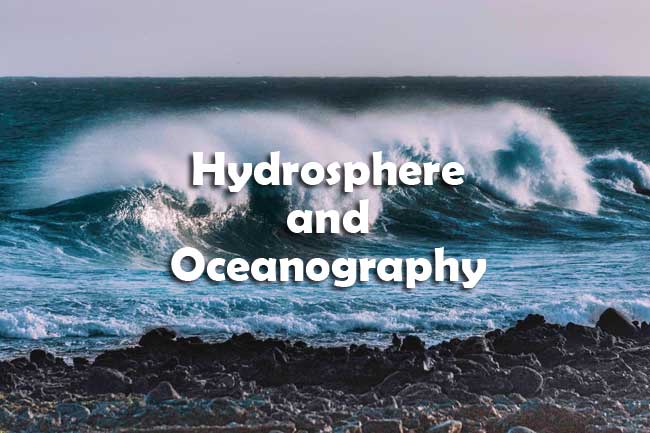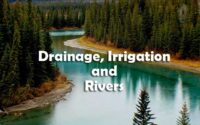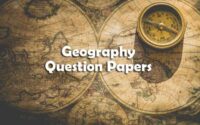Hydrosphere and Oceanography Questions and Answers
Hydrosphere and Oceanography Questions and Answers Papers pdf will be available here for download. Therefore, all the contenders can make use of this chance and start to download the Hydrosphere and Oceanography Solved Question Papers.

Because by solving the Hydrosphere and Oceanography Objective Model Papers you can improve your knowledge. Also, check for download the Hydrosphere and Oceanography MCQ Papers with Solutions from the link provided below. The Hydrosphere and Oceanography Quiz helps you to prepare well for the exam topic wise and obtain very good marks.
Therefore, go through this post thoroughly and download the Hydrosphere and Oceanography Last Year Question Papers. All these questions on Hydrosphere and Oceanography are collected from previous year papers and compiled by us.
Questions and Answers on Hydrosphere and Oceanography
1. Which from the following can cause a tsunami ?
(A) Volcano
(B) Avalanche
(C) Tornado
(D) Earthquake
2. The coastal part of water bodies of the oceans which is structurally part of the mainland of the continents is called
(A) Isthumus
(B) oceanic ridge
(C) continental shelf
(D) continental slope
3. Mariana Trench is found in
(A) Atlantic Ocean
(B) Pacific Ocean
(C) Indian Ocean
(D) Arctic Ocean
4. Which one of the following ocean currents does not occur in Atlantic Ocean ?
(A) Gulf stream
(B) Brazil current
(C) Peru current
(D) Canary current
5. The main cause of Tsunami is :
(A) Volcanoes
(B) Cyclones
(C) Earthquake on sea floor
(D) Moon’s attraction
6. Tides are caused by the gravitational pull of the
(A) Earth on the Moon
(B) Earth on the Sun
(C) Sun and Moon on the Earth
(D) Moon on the Earth
7. Tides in the sea are caused by
(A) effect of Sun
(B) effect of Moon
(C) combined effect of Moon and Sun
(D) gravitational force of Earth and Sun
8. Sea water is saltier than rain water because
(A) rivers wash away salts from earth and pour them into the sea
(B) sea beds have salt producing mines
(C) sea animals are salt producing
(D) the air around the sea is saltish
9. In sea, plants are restricted up to the depth of
(A) 20 m
(B) 200 m
(C) 1000 m
(D) 2000 m
10. El Nino occurs over
(A) Atlantic Ocean
(B) Indian Ocean
(C) Pacific Ocean
(D) Mediterranean Sea
11. The Sargasso sea is situated in the :
(A) Atlantic Ocean
(B) Pacific Ocean
(C) Indian Ocean
(D) Arctic Ocean
12. The eastward continuation of the Brazil current is called:
(A) South Atlantic drift
(B) Counter Equatorial drift
(C) West Atlantic drift
(D) North Atlantic drift
13. The rapidly growing mass of phytoplankton covering the surface water of a lake or pond is known as :
(A) Eutrophication
(B) Water bloom
(C) Water pollution
(D) Water hyacinth
14. Which one of the following is a warm ocean current ?
(A) Kurile
(B) Canary
(C) Labrador
(D) Gulf Stream
15. The rhythmic rise and fall of ocean water twice in a day is called
(A) Tide
(B) Ocean current
(C) Wave
(D) Water cycle
16. Neap tides are
(A) Strong
(B) Weak
(C) Medium
(D) Very strong
17. The Ocean with the largest surface area is
(A) Arctic Ocean
(B) Atlantic Ocean
(C) Indian Ocean
(D) Pacific Ocean
18. The largest current, because of its dark waters is known as the ‘black current’ and that is :
(A) Gulf Stream
(B) Kuroshio Current
(C) California Current
(D) Antarctic Current
19. Spring tides occur on
(A) New moon day only
(B) Full moon day as well as on new moon day
(C) Full moon day only
(D) The day when the moon’s position is in its first quarter
20. Best way to conserve our water resources :
(A) Rain water harvesting
(B) Sustainable water utilization
(C) Encouragement of natural regeneration of vegetation
(D) All of the options mentioned here.
| Physical Geography | Atmosphere |
| Bio Geography | Earth landform |
| Soil Geography | Universe and Solar System |
| Hydrosphere |
21. The smallest ocean is :
(A) Atlantic
(B) Pacific
(C) Indian
(D) Arctic
22. How much of world’s surface is covered by water?
(A) 55%
(B) 70%
(C) 80%
(D) 25%
23. The largest reservoir of fresh water is :
(A) Glaciers
(B) Ground Water
(C) Ponds
(D) Lakes
24. A semi enclosed coastal body of water which has a free connection with the open sea is called
(A) Estuary
(B) Fjord
(C) Cove
(D) Ria coast
25. El Nino is
(A) a warm ocean current
(B) sea storm
(C) tropical disturbance
(D) another name of typhoon
26. The narrow stretch of water connecting two Seas is called
(A) Bay
(B) Peninsula
(C) Isthamus
(D) Strait
27. The largest ocean is
(A) Atlantic Ocean
(B) Indian Ocean
(C) Arctic Ocean
(D) Pacific Ocean
28. Which current is responsible for increase in the temperature of the western Europe ?
(A) Labrador current
(B) Gulf stream
(C) Canari current
(D) North Equatorial current
29. Tsunamis are cuased by
(A) mixing of cold and warm currents
(B) earthquakes
(C) changes in sea level
(D) volcanic eruption
30. Seismic sea waves which approach the coasts at greater force are known as
(A) Tides
(B) Tsunami
(C) Current
(D) Cyclone
31. Which of the following is a cold ocean current ?
(A) Humboldt current
(B) Brazil current
(C) Oyashio current
(D) Canary current
32. Sea breeze is formed during
(A) Day time
(B) Night time
(C) Both
(D) Seasonal
33. The coral reefs are the marine counterparts of
(A) Temperate forests
(B) Tropical rain forests
(C) Savannahs
(D) Scrubland
34. The deepest ocean is-
(A) Arctic
(B) Pacific
(C) Atlantic
(D) Indian
35. Two seas or water-bodies connected by a narrow stretch of water is known as a
(A) Bay
(B) Strait
(C) Peninsula
(D) Isthmus
36. Waves approaching the shore is known as
(A) Swash
(B) Tsunami
(C) Currents
(D) Tide
37. Atoll is a kind of
(A) sand-dune
(B) lake
(C) sandbar
(D) inland sea
38. The coastal part of water bodies of the oceans which is structurally part of the mainland of the continents is called the
(A) Isthmus
(B) Oceanic ridge
(C) Continental shelf
(D) Continental slope
39. Which one of the following is not a cold ocean current?
(A) California
(B) Oyashio
(C) Kuroshio
(D) Ganaries
40. The term territorial water means
(A) The water found within the country in form of rivers and lakes
(B) The water secured from other countries
(C) The water which is supplied to other countries
(D) Water of the sea located close to the coast of a country
41. The ocean which touches the Asian and American shores is
(A) Atlantic
(B) Indian
(C) Antarctic
(D) Pacific
42. The ‘EL Nino’ phenomena which sparks climatic extreme around the globe, originates in the
(A) Sea of China
(B) Pacific Ocean
(C) Indian Ocean
(D) Atlantic Ocean
43. Terrigenous deposits are found in
(A) Deep Sea Plain
(B) Ocean Trenches
(C) Rift Valley
(D) Continental Shelf and Slope
44. ‘El Nino’ that affects our Monsoons, has its origins in
(A) The Indian Ocean
(B) The Himalayan Plateau
(C) The Pacific Ocean
(D) The Arabian Peninsula
45. Where is the Great Barrier Reef located ?
(A) Pacific Ocean
(B) Indian Ocean
(C) Atlantic Ocean
(D) Arctic Ocean
46. A wide inlet of the sea usually concave in shape, is termed as a:
(A) Strait
(B) Sound
(C) Bay
(D) Fjord
47. The gentle ‘seaward sloping’ surface from the coasts is called __________.
(A) Continental shelf
(B) Continental rise
(C) Abyssal plains
(D) Submarine ridges
48. Ring of Fire is found commonly in _____
(A) Pacific Ocean
(B) Atlantic Ocean
(C) Indian Ocean
(D) Arctic Ocean
49. “Great Barrier Reef”, the world’s largest Coral reef is located in
(A) Caribbean Islands
(B) Australia
(C) Philippines
(D) Indonesia
50. The deepest trench of the Indian Ocean is
(A) Java trench
(B) Aleutian trench
(C) Atacama trench
(D) Tizard trench



